It might be a week and a half until the WSL returns to action, but other tiers of the English women’s football pyramid are already underway. One division worth watching this year is the Women’s Championship, which could play host to a closely contested fight for promotion, and two teams fancied to be in the mix are Charlton Athletic Women and London City Lionesses (last season’s runners-up), who met at The Oakwood (Charlton’s home stadium) on Sunday. Both sides needed the win, but for different reasons, with the hosts hoping to build on last weekend’s win whilst the visitors were aiming to kickstart their campaign into life after a disappointing home loss last time out.
This tactical analysis will look in detail at this London derby clash, which ended up being “an exciting game for the neutrals”, as Charlton manager Karen Hills put it afterwards. The analysis will show how Charlton were let down by their defensive problems and will explain how their system didn’t match their tactics, as well as why London City’s offensive threat helped them to edge their hosts and take all three points.
Lineups
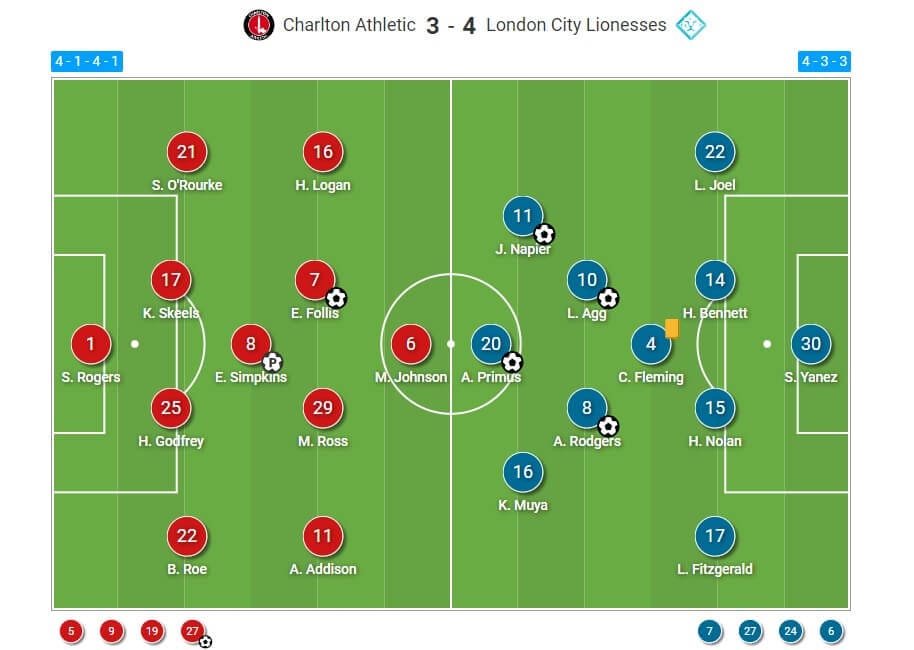
After their win at league newcomers Southampton Women, Charlton Athletic Women opted not to make changes to their starting eleven, hoping that continuity would lead to a second win of the campaign. On-loan Aston Villa Women stopper Sian Rogers, therefore, kept her place between the nets, with Kiera Skeels and the former Tottenham Hotspur Women defender Hannah Godfrey once again pairing up in central defence. Bethan Roe and Sophie O’Rourke started either side of them, whilst captain Emily Simpkins offered a protective presence in the hole.
Ex-Tottenham winger Angela Addison joined Mia Ross, Emma Follis and Heidi Logan in the four ahead of her, whilst Melissa Johnson, who joined after leaving league rivals Bristol City Women last season, once again led the line.
London City Lionesses, however, made three alterations from last weekend’s starting XI after the loss to Crystal Palace Women, with full-backs Grace Neville and Lois Heuchan dropping to the bench and former Birmingham City Women and Celtic Women striker Sarah Ewens picking up an injury. Lois Joel, who joined after leaving West Ham United Women this summer, and Lucy Fitzgerald both came off the bench to start in the full-back areas, whilst Jamaica international Atlanta Primus led the line on her own in Ewens’ absence, with Charlotte Fleming included in her place to bolster the midfield.
Charlton Athletic Women’s tactical changes
Following their positive start to the campaign, former Tottenham co-manager Hills would have no doubt been hoping that her side could continue their strong start to the season and pick up their first home victory. However, they were let down by their tactics and system not matching up, meaning that the players quickly found themselves up against it.
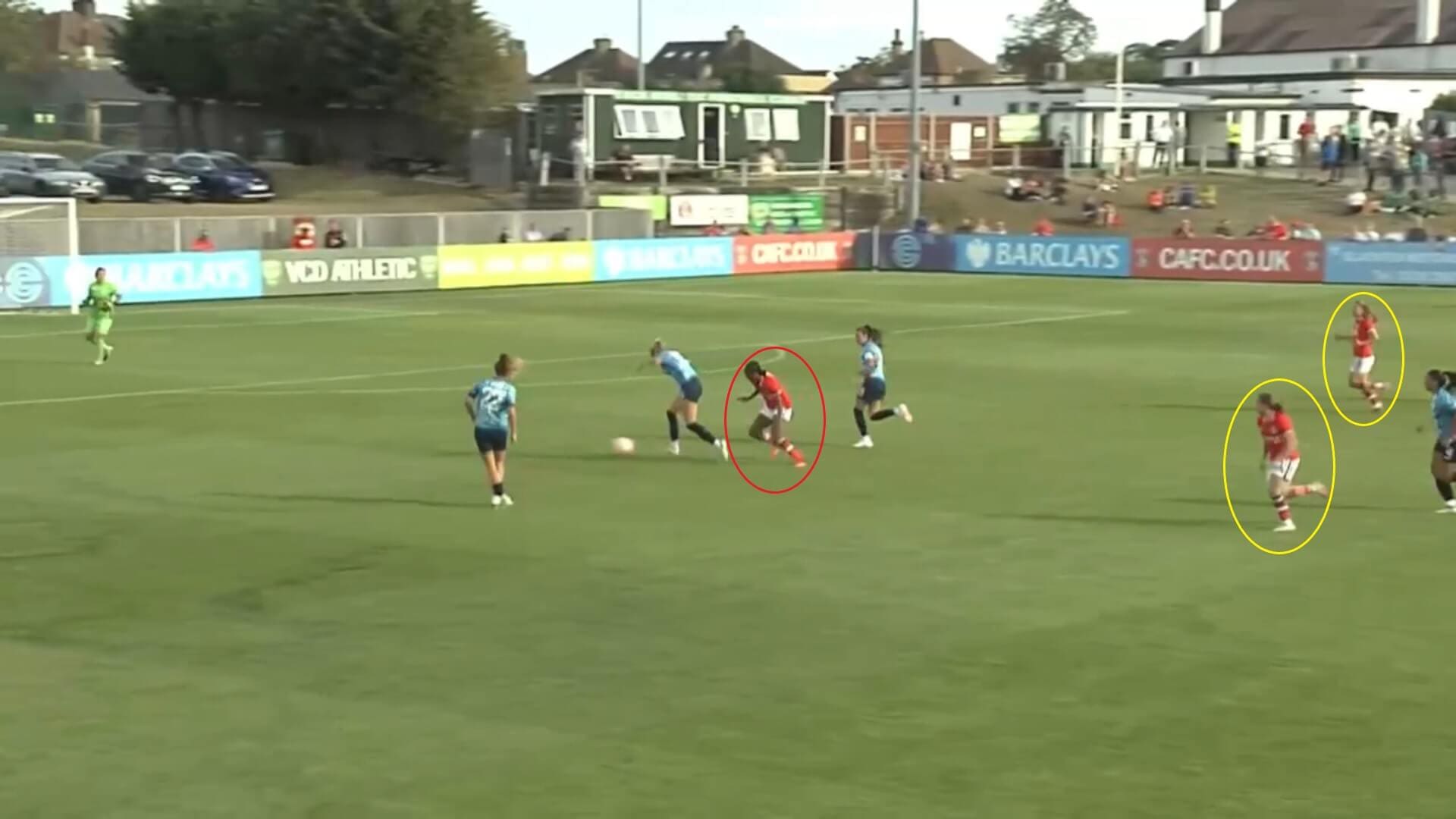
Charlton Athletic Women’s basic game plan was clear from the early stages, with the players constantly urged to press high and look to trap individual London City Lionesses players in small sections of the field, forcing mistakes. However, whilst they started well and had the first effort on goal, their 4-1-4-1 system prevented these tactics from having a great effect on the game, as Melissa Johnson lacked support from those behind her. As a result, it became easy for London City to isolate her and beat the press, as is the case here.
The problem is that the system isn’t really designed for teams who want to play with the tactics that Charlton had here, because it lends itself more to sides who want a target player and balance throughout the rest of the team, aiding them in transitions. As a result, the wide players tend to stay back more and work closely with the midfielders to move the ball around the pitch, which is why Angela Addison and Heidi Logan didn’t get forward as often as they needed to here in order to help Johnson apply pressure on the London City back line.
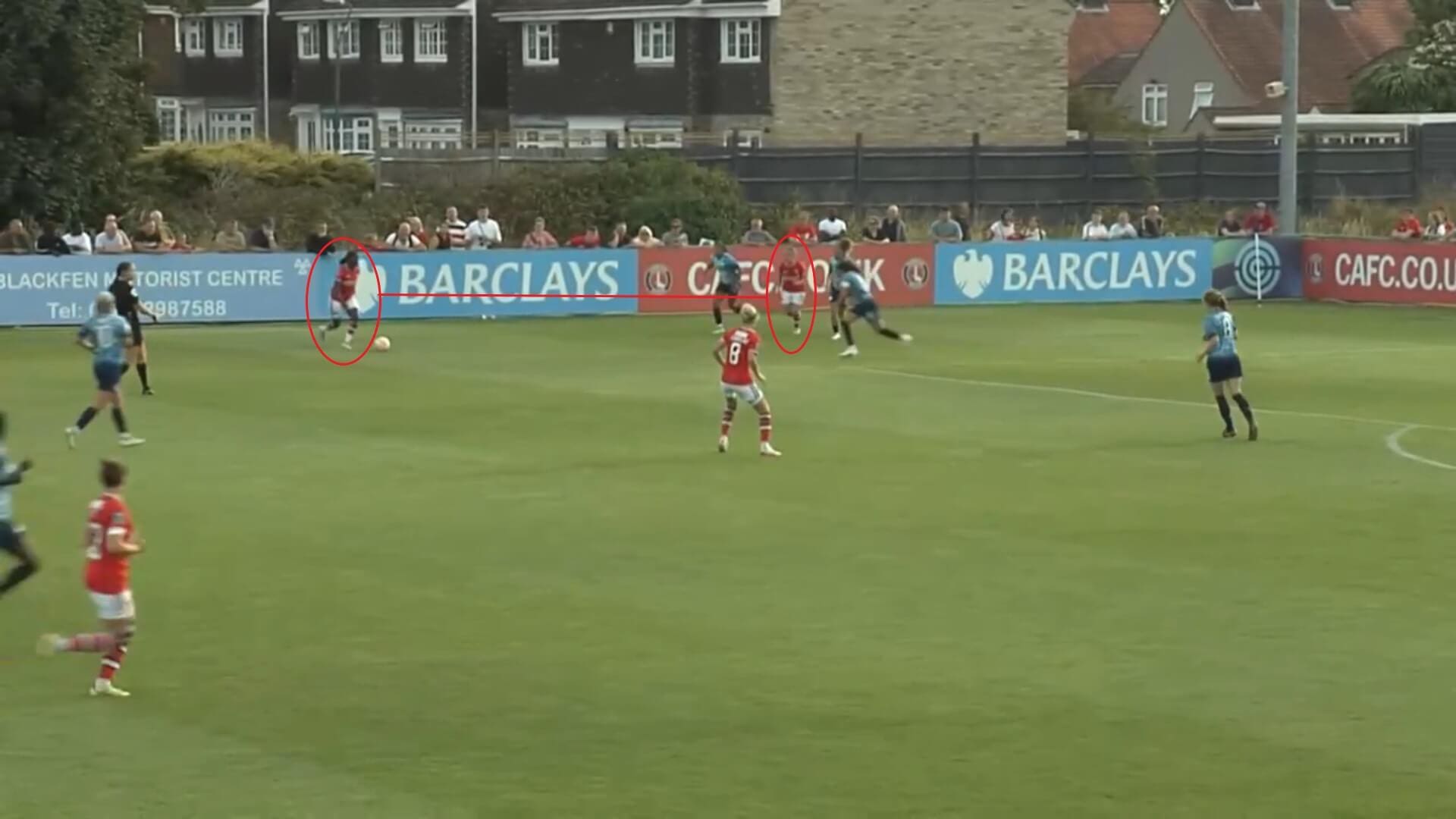
This was obviously something that the coaching team observed during the first half because Charlton made changes at the break and played with greater intensity in the second half. The decision to introduce another Aston Villa loanee, this time defender Elisha N’Dow, as well as forward Freda Ayisi (with Heidi Logan and Mia Ross making way) gave the home side three central defenders and another wide attacking option, and the result was that both Bethan Roe and Sophie O’Rourke could get further forward and create numerical overloads on the wings with Ayisi and Angela Addison, helping to create more problems for their opponents.
This situation shows the positive effect that this tactical switch had, with Ayisi and Addison on the same side and able to get higher up the field and deliver the ball into the box at the right moment. This particular cross led to their equaliser, scored by Emma Follis, and that highlights another positive of the change, as Follis and others had more freedom to move around the pitch and get on the ball in different positions. In the first half, this had not been the case, as they had been limited by the 4-1-4-1 system.
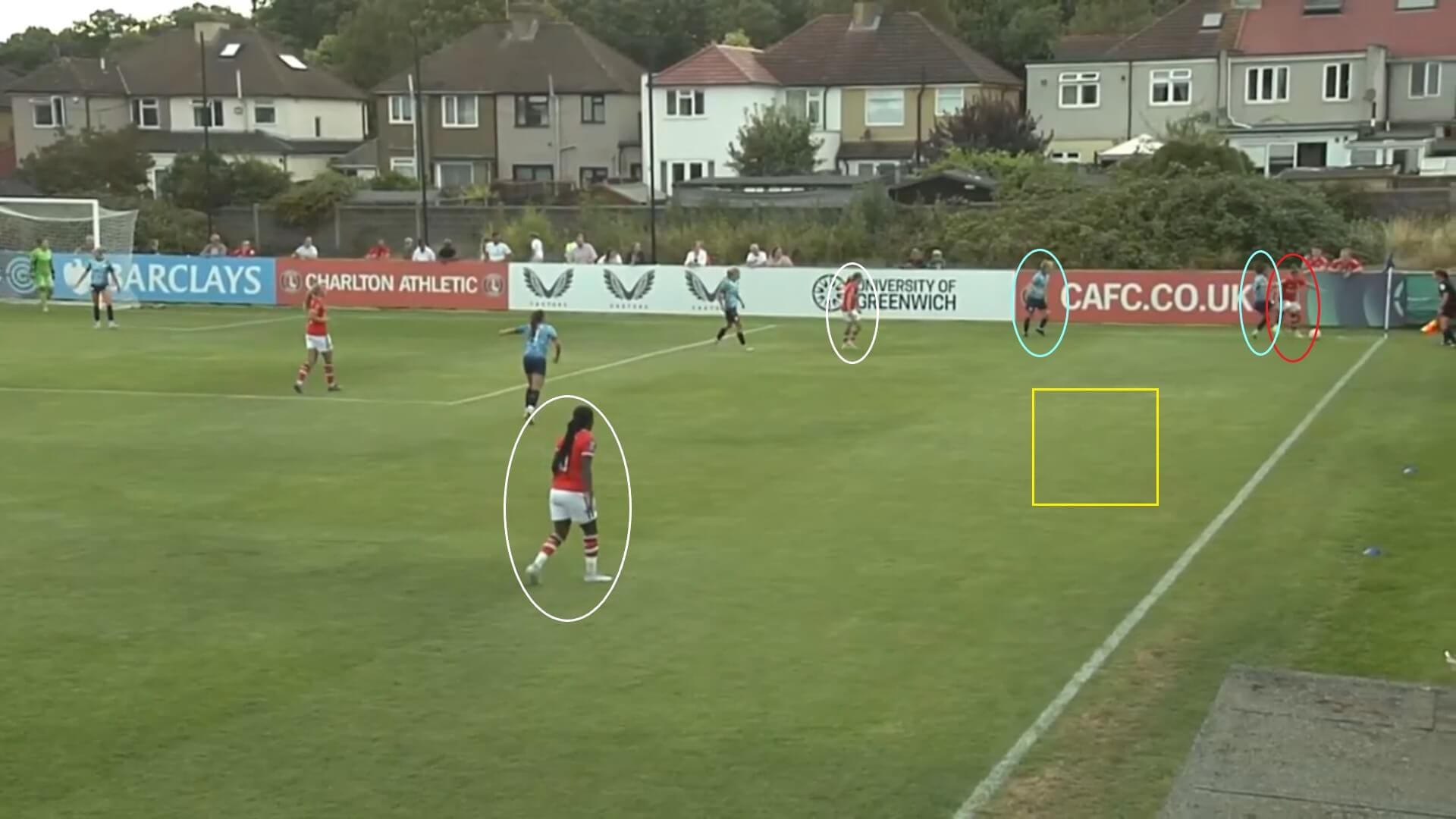
Whilst the tactical change was largely positive, there were still a few areas that limited their improvement, with situations like this occurring when they didn’t communicate and work together. In this case, Roe has got up the field and has been forced into the corner by London City’s former Chelsea Women winger Jamie-Lee Napier, limiting her options on the ball.
What she needs now is for a teammate to move into the area marked by the yellow square, not only enabling her to move the ball out of danger but also giving her teammates a chance to cross it into the box. However, neither of the two players in a position to help her out do so, with Ayisi and Addison (in the white circles) instead holding their positions and waiting for the ball to come to them. As a result, it is easy for left-back Lucy Fitzgerald to come across and help Napier to force the ball out of play.
There is no doubt that Charlton were much better in the second half after their structural change, but they ended up losing the game by one goal, and chances like this will be where they will feel that they could have done better.
Charlton Athletic Women’s defensive problems
However, despite their lack of attacking quality at times, it was in defence where Charlton Athletic Women really let themselves down in this game, with set-pieces a particular issue for them. This is what they will need to work on the most during the week because some of the goals that London City Lionesses scored were just too easy and will give other teams ideas on how to beat Charlton during the rest of the campaign.
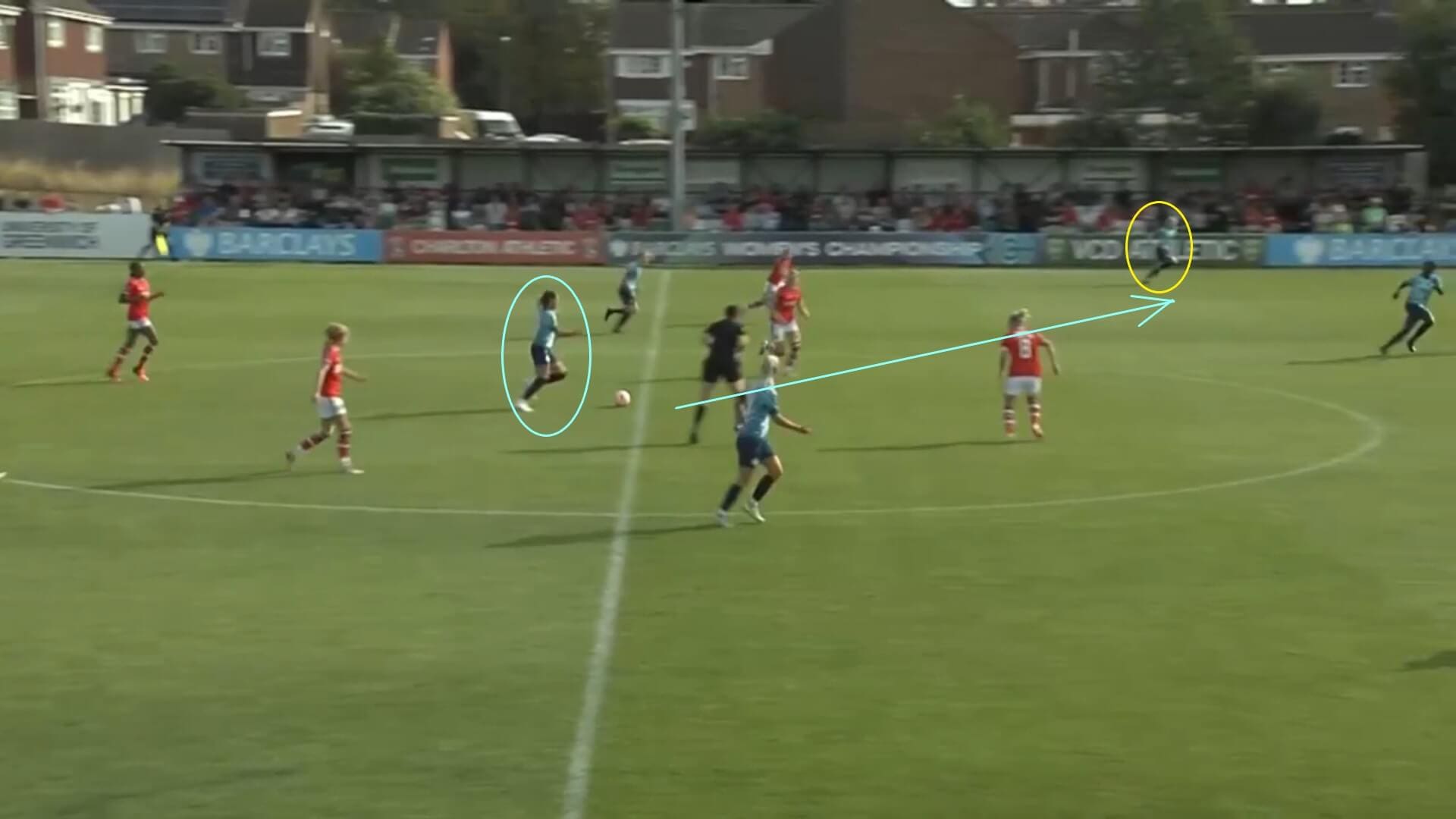
It was mentioned in the previous section that the 4-1-4-1 system used by Charlton is mainly used to limit what opponents can do in the central third and to aid transitions. However, once London City had found their feet and grown into the game, Charlton’s ability to control the middle of the field disappeared, with the visitors pushing forward and looking to exploit the holes in the home side’s lines. Here, centre-back Harley Bennett has taken the ball up to the halfway line before sending the ball towards Fitzgerald on the far side, and the fact that this pass led to the first goal of the game only a few moments later shows the danger that this posed to Charlton.
Ultimately, the key point is that Charlton increasingly played into their opponents’ hands as the first half went on, with London City’s game plan revolving around absorbing Charlton’s pressure and then counterattacking at pace when they had the chance to do so, using their wingers and full-backs to transfer the ball into the spaces behind the defenders. Therefore, this is one reason that Charlton’s defensive errors led to their eventual defeat.
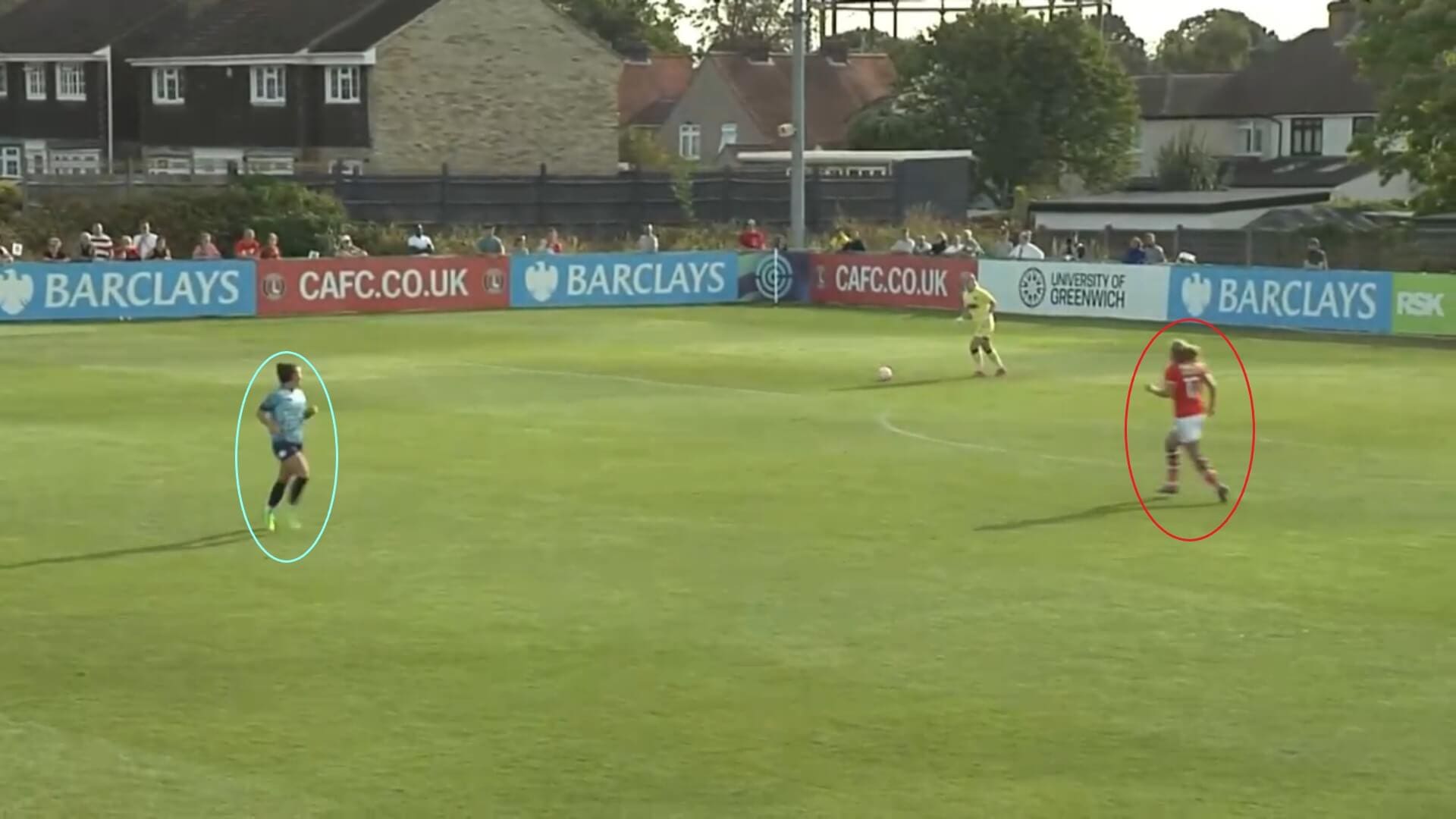
Another problem was that Charlton tried to be too clever at times, playing out from the back whenever Sian Rogers had the ball, and this situation shows the danger that this led to. Rogers has Kiera Skeels nearby and is looking to pass the ball into her, but Napier is also there and is ready to take advantage of any loose balls. This happened more and more as the game went on, with London City reading what Charlton were doing and looking to force mistakes, and the home side only just got away with it here as Napier, who is one of the second tier’s quickest players, was close to winning the ball here and the goal would have been at her mercy.
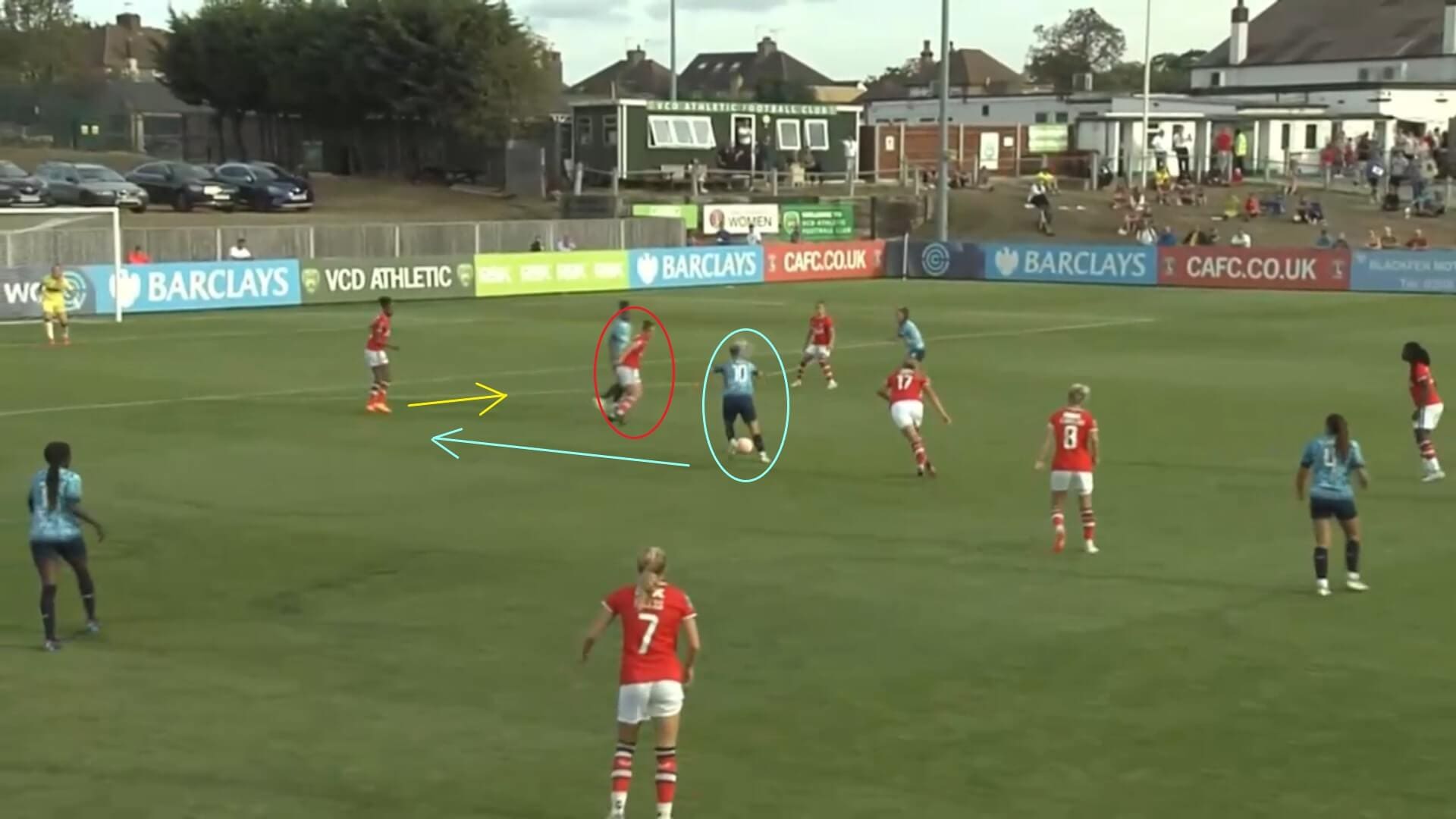
Even in the second half, when N’Dow had come on to add an extra body at the back, Charlton still left spaces open and made it easy for London City to create opportunities to score against them. Here, a loose pass (one of many made during the game) has given Lily Agg the ball in a dangerous position, with Hannah Godfrey unable to win the ball back from her. As a result, N’Dow, behind Godfrey, needs to hold her ground and prevent Agg from having a clear view of the goal. However, Agg’s link-up play with Atlanta Primus draws her out of position, as the yellow line shows, and only a mishit effort from Agg prevents this turning into a goal for the away side.
Ultimately, when Charlton look back at this performance, these are the situations that they will pick up on as areas to work on because there is no doubt that they made it far too easy for London City to create chances against them and to score at times.
London City Lionesses’ offensive threat
Whilst there is no doubt that Charlton Athletic Women were largely the source of their own problems in this game, it is important to remember that London City Lionesses still had to play well in order to gain the win. One major positive in their performance was their offensive threat and ability to use spaces, as this helped them to keep the ball moving and break their opponents down.
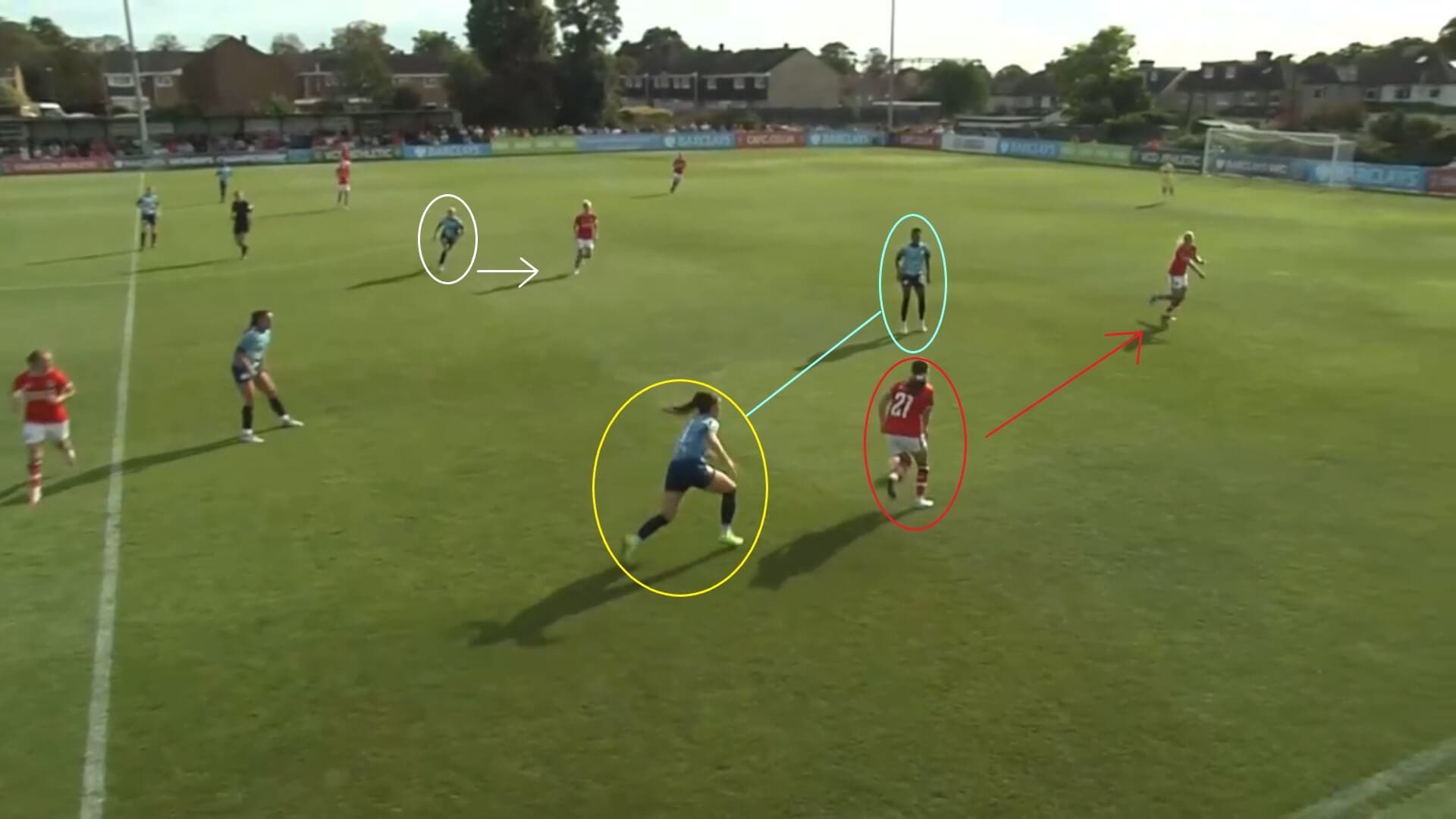
Like Charlton, London City also had one player at the top of the field, but their tactics were much better suited to their system and enabled them to keep the pressure on the home side in their own third.
The key role was played by Primus, who drifted around the pitch depending on where the ball was and combined with the winger on that side of the field, creating 2-v-1 overloads and limiting their options. In this case, O’Rourke has possession, meaning that Primus has come over to the nearside to work with Napier and limit the left-back’s options. O’Rourke’s only possible choice now is to pass backwards towards Skeels, hoping that the ball can then move across the pitch and into space. However, once former Reading Women defender Skeels has possession, Primus breaks off and moves back towards the middle, before then drifting over to combine with Karin Muya on the opposite side once the ball reaches the other wing.
The other advantage of this tactic for London City is that it brought other key players into the game, such as Agg and former Liverpool Women midfielder Amy Rodgers. In this case, Agg has moved up the field to mark Emily Simpkins here, taking that pass away from O’Rourke, and having the creative attacking potential of those two players in the final third was another reason that Charlton struggled to contain the Lionesses.
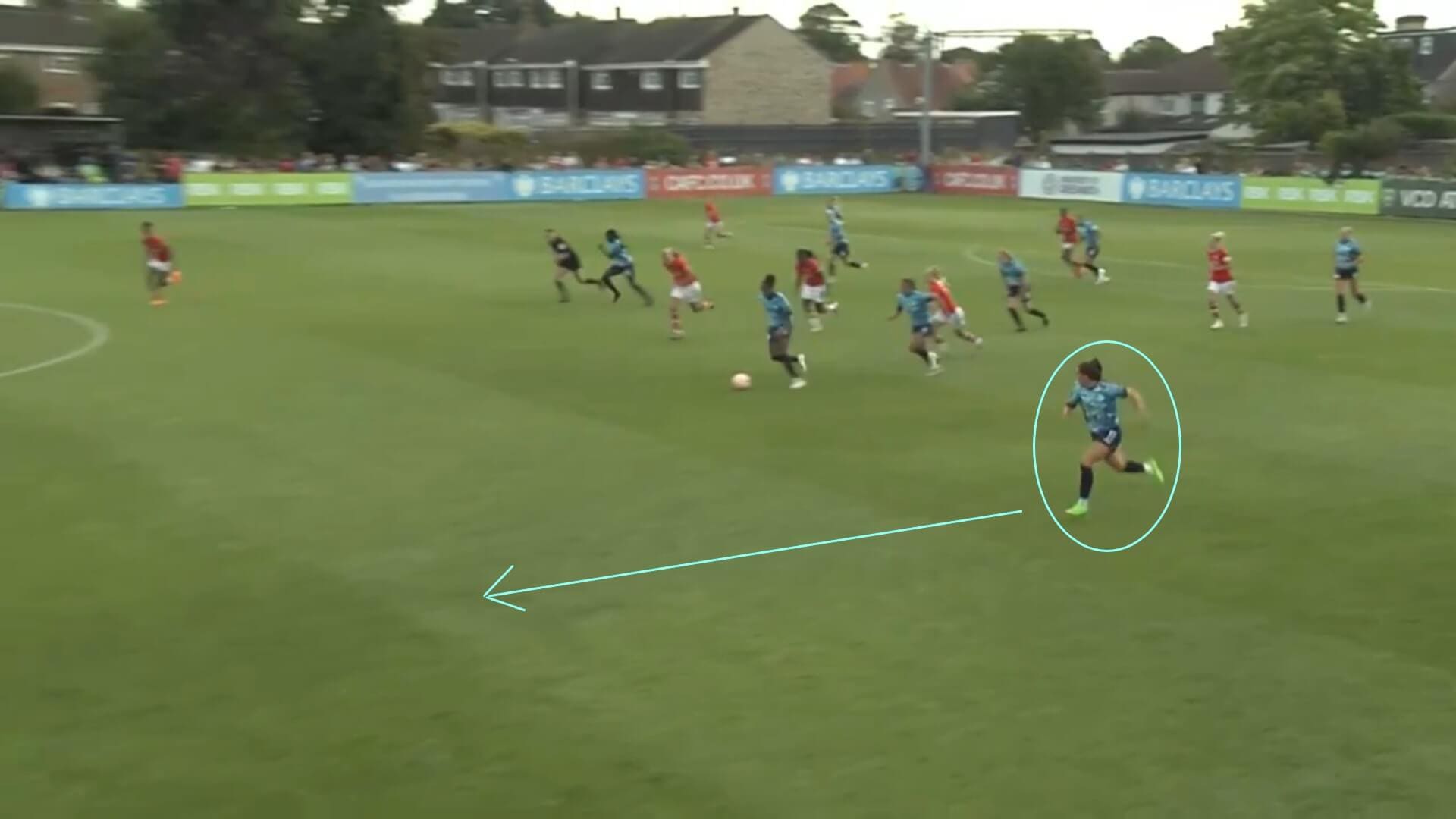
Their tactical decision to soak up pressure and counterattack against Charlton has also already been mentioned in this analysis, and its success was helped by the raw pace that they had in the wide channels from Napier and Muya. As a result, when Primus won the ball and looked to move it up the field, she generally had options to find and was able to exploit the spaces left open by the home side, which was something that Charlton weren’t able to do as much of, particularly in the first half.
Even though the Scottish winger ended up firing across goal and wide, this situation highlighted once again the threat that the away side posed when moving forwards and the pressure that they were putting on their opponents.
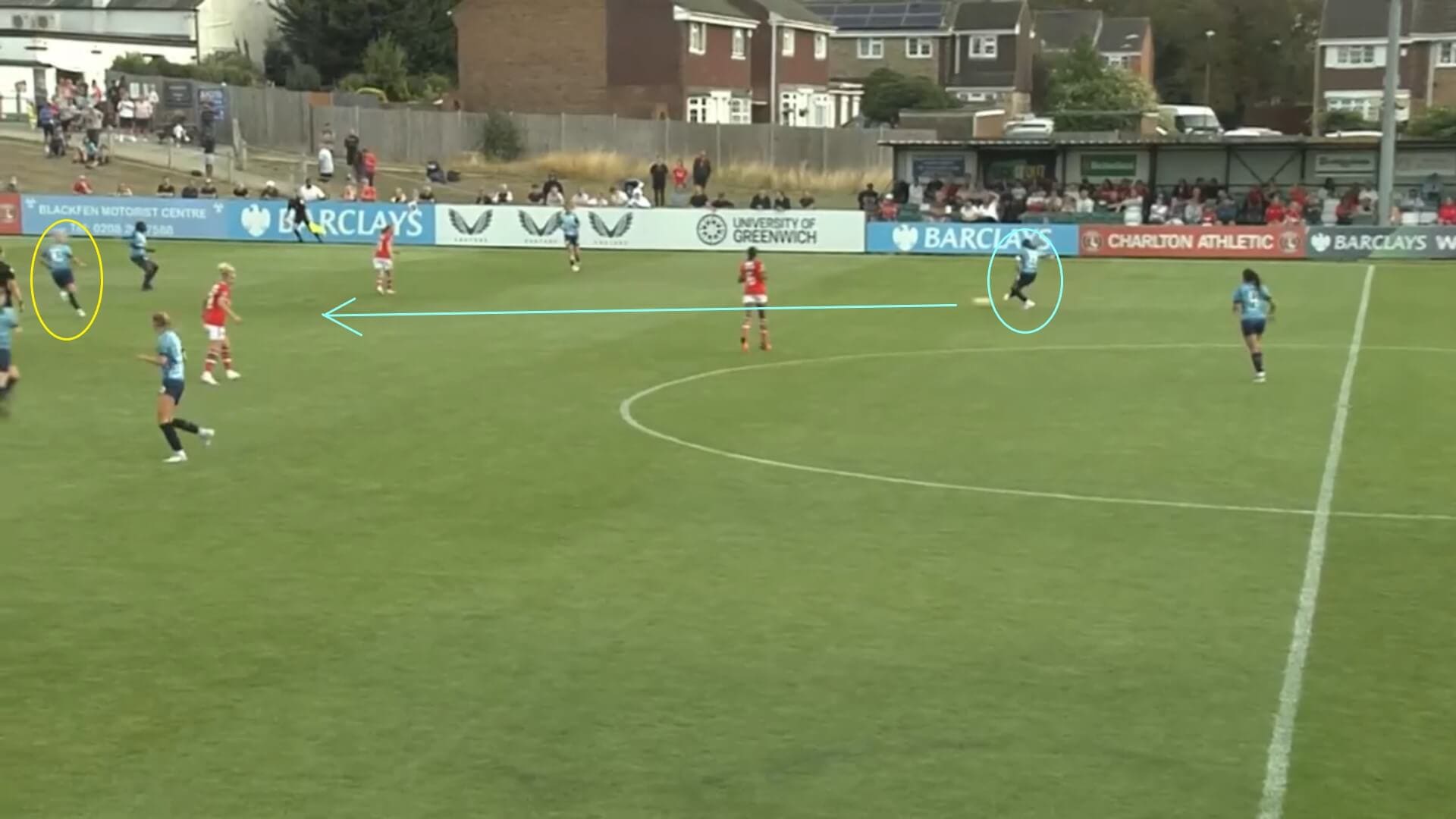
There wasn’t a great need to change things in the second half, as Charlton continually allowed them to play into spaces and create goalscoring opportunities. Again, Bennett has had time to advance up the pitch unchallenged here before passing forwards to Agg, and not limiting the influence of her and Rodgers as the game progressed was one of the home side’s key errors, due to Agg’s goalscoring abilities and Rodgers’ playmaking qualities, as well as the fact that the latter was the team’s top scorer last season with seven goals.
Whilst this specific move didn’t lead to anything, Rodgers scored arguably the goal of the game only a few moments later, finding the top corner from the same area that Agg is in here. Therefore, again, Charlton were punished for not heeding the warning signs and preventing the visitors from playing through them.
Conclusion
In conclusion, this tactical analysis has looked in detail at the Women’s Championship match between Charlton Athletic Women and London City Lionesses, breaking down the reasons for London City edging their opponents and taking the win.
Whilst it is still early in the campaign to draw conclusions from this result, what can be said is that Charlton have to tighten up on plenty of aspects of their performance if they want to stay in the promotion fight because defensive errors and general untidiness in possession prevented them from taking anything from the game despite scoring three times.
London City, meanwhile, will be pleased with their overall display and, most importantly, their reaction after last weekend’s defeat, and edging an encounter whilst playing with this level of quality will give them plenty of belief that they can challenge for promotion once again.
After the international break, Charlton will look to get their campaign back on track when they visit early-season strugglers Coventry United Ladies, whilst London City’s next game sees them host fellow pre-season promotion contenders Bristol on the same day.





Comments